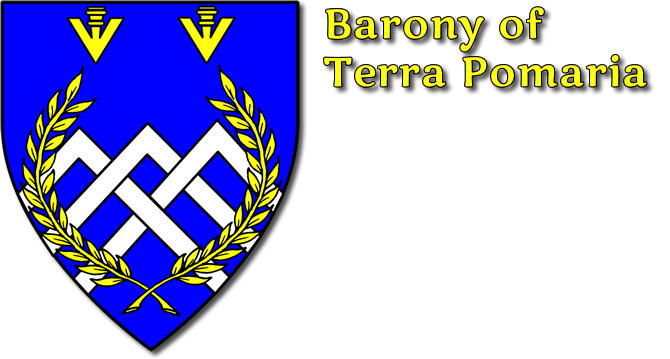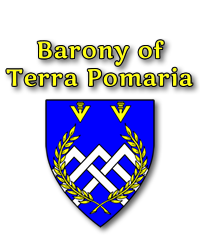19 Nov Corance to Potage
Then Serve It Forth…
By Lady Rosemary Willowwood de Ste. Anne
November draws swiftly on. Frost is here and the grass is no longer plentiful for the cattle. The thrifty farmer must now make the hard choice of which stock to nurture through the lean winter. Thomas Tusser advises the farmer, in his “Five Hundred Points of Good Husbandry” that, “At Hallontide slaughter time entereth in, and then doth the husbandmans feasting begin: From now until Shrovetide kill now and then some, Their offal for houshold the better will come.” Hallontide is another word for the holiday we know as “Halloween”, or “All-Hallows”, and Shrovetide is the beginning of the meatless Lenten season, so animals slaughtered then would go to waste. Such a meal as “offal” sounds less appetizing than modern taste would credit, since we tend to make much less use of organ meats than our predecessors did. But to the period folks, the “offal” provided a prized treat known as,
“Corance to Potage” (“Variety meat” stew)
From Ancient Cookery, Arundel Collection No. 344, pp. 275-445
From about 1326-1399
Take nombuls of a calf, or of a swyne, or of a shepe, and parboyle hem, and then cut hem smale and do hem in a pot; and take sage and parcyl, ysyp, savery and green chebolles, and hew hem smal, and do therto and alay hit with the yolkes of egges, and color hit with saffron, and in the setting downe do thereto verjus and pouder of canel, and of cloves, and of ginger medelet togedur, and serve hit forthe.
TRANSLATION: Take numbles (“innards”; see glossary and discussion below) of a calf, or of a pig, or of a sheep, and parboil them, and then cut them small and put them in a pot. And take sage and parsley, hyssop, savory, and green scallions, and chop them small, and add thereto, and thicken it with the yolks of eggs and color it with saffron, and in the serving, add verjuice and powder of cinnamon and of cloves and of ginger mixed together, and serve it forth.
REALIZATION: This recipe can be made with any combination of “variety meats”. Culinary tradition in England makes customary pairings of steak with kidney, liver with lights (lung), or tripe with sweetbreads. For ease of preparation, and the best taste, choose meat types that have similar textures and will stand up to similar cooking times, which tend to be long. Also, cleanliness is critical here, and especially with kidneys, a two- to three-hour soak in several changes of salted water will not go amiss. I will use heart and kidney in this realization, but you are limited only by your imagination.
Cut 1 pound of well-soaked beef or lamb kidneys into ½ inch dice. Parboil for 5 minutes in additional salted water, which may be discarded. Dice 1 pound of beef heart into ¾ inch cubes. Brown both heart and kidney meat in oil. Add just enough strong broth (beef or onion) to be seen, but not to cover the meat. Simmer over low heat for 2-3 hours, or until tender. Add additional broth if necessary. Add 2 tsp. each of chopped sage, parsley, savory, and hyssop or mint, with about 1 cup of chopped scallions during the last hour of simmering. Add about 2 tablespoons of verjuice or vinegar, and drain the broth. Thicken the broth with about one egg-yolk per cup of broth. This is done by briskly beating the egg yolks until thick and smooth, pouring in about one cup of hot broth while beating, then beating the warmed egg yolks back into the remainder of the broth. Stir constantly over low heat until thickened, then stir back into the reserved meat. Serve as stew, with a sprinkle of equal parts of cinnamon, ginger, and cloves, or serve a bowl of mixed spice on the side for diners to add to taste.
This dish has an interesting and complex history. “Numbles of a Deer” is one of the oldest dishes for which we have a recipe, noted in the Oxford English Dictionary, 2nd ed. as 1239.. :Numbles” were defined as “loin of veal, fillet of beef or venison, chine of pork.” Pliny notes it as a diminutive of lumbas, loin. This definition is where the “steak” in British “Steak and Kidney Pie” comes from. Another definition from Oxford English Dictionary, 2nd ed. is “certain of the inward parts of an animal (chiefly those of a deer) as used for food. Also in early use, part of the back and loins of a hart.” Custom in the early Middle Ages gave this portion of the felled deer to the huntsman. This portion was curiously both a reward and a reminder of the huntsman’s lower station; the best parts of the animal went to the man who brought the animal down. (This was typically the “pluck” or heart, and the testicles [really!].) The rest of the edible organ meats went to the hunting crew and the rest of the huntsmen, frequently to be cooked and eaten in the field. The less desirable (or inedible) offal was thrown to the dogs. So the inclusion of the recipe in the cookbooks of the noble estate reminds us that one of the duties of the noble was to provide meat for the household, often through hunting. Yet the rest of the same type of meat was thrown to the dogs as waste.
Now we get to some later transformations of the word. “Numbles” was also “umbles”, and by the time Sir Kenelm Digby was writing, had become “humbles”. In fact, Sir Kenelm has a recipe entitled, “To season Humble-Pyes”. In fact, the seasonings are almost the same as the one above. Digby’s whole recipe reads, “Bake Humble-Pyes without chapping them small in a Pye, seasoned with Pepper and Salt, adding a pretty deal of Parsley, a little sweet marjoram and Savoury, and a very little Thyme.” By the 1800’s, “humble pie” had become identified with the food of the lower classes, and “to eat a slice of humble pie” was to abase one’s dignity, often to accept shame. So the question arises: How did a dish fully acceptable to and often a reward to a noble lord in 1239 become synonymous with lower classes and shame? What a topic for discussion at a tournament!
GLOSSARY:
Numbles: Inwards of a deer or other large “red-meat” animal, such as a pig or sheep. Also written “umbles”, or “humbles”. Not, however, to be confused with the inwards of a fowl, which were known in the period as “garbage”. Neither term was pejorative, and both sorts of organ meats were highly valued as tasty dishes.



